
| KIT #: | 04208 |
| PRICE: | Currently out of production |
| DECALS: | none included |
| REVIEWER: | Frank Spahr |
| NOTES: |
These items used: White Ensign
Models PE set #632 - listed in catalogue @16.98 GBP - I paid 33.20 EUR Starfighter Decals Sheet 600-1 Fleet Air Arm 1940-44; 6$; contact starfighterdecals@verizon.net |

| HISTORY |
The Royal Navy has so far had five ships named Ark Royal. The first was built in 1587 on the orders of and paid for by Sir Walter Raleigh; originally called "Ark Raleigh". Queen Elizabeth bought the ship for 5,000 pounds whereupon the vessel was renamed "Ark Royal". The first Ark Royal was a successful ship and flagship of the English fleet in the 1588 battle with the Spanish armada.
The second Ark Royal was a merchant vessel hastily converted into a seaplane tender at the outbreak of WW I. Since then all subsequent Ark Royals have carried aircraft. The second Ark Royal was renamed HMS Pegasus in 1934 to free up the name for a new aircraft carrier then in the planning stages, it is this vessel which is the subject of this review.
HMS Ark Royal (II)I was the second British purpose-built aircraft carrier after HMS Hermes, a great step forward from previous designs, in various respects she was the most advanced carrier of her time. She was built to make the most of the limitations imposed by the Washington treaty, combining speed with a vastly improved aircraft complement, up to 72 planes in two hangars above each other. Contrary to contemporary vessels, her flight deck was integral to the construction of her hull, making for a very sturdy vessel with welding used extensively in her construction to save weight.
She was built at a time when the Royal Navy finally regained control of the Fleet Air Arm from the Royal Air Force, thereby ending a period when naval aviation was often considered and equipped in a somewhat second-rate manner. Sadly, development of improved carrier planes came too late for the outbreak of WW II, nevertheless the Fleet Air Arm performed admirably bearing in mind what they had to fight with.
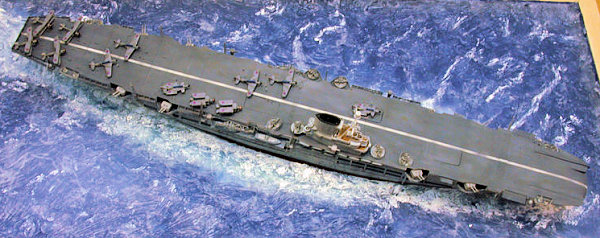 HMS
Ark Royal was commissioned in December 1938, a
time when war with Hitler´s Third Reich became ever more inevitable. Her first
captain, Arthus Power, addressed his crew in January 1939 with the following
words: "Is there any man here with his hand on his heart who can say that we
will not be at war in six months? It´s my job to get this ship welded together
as a fighting ship."
HMS
Ark Royal was commissioned in December 1938, a
time when war with Hitler´s Third Reich became ever more inevitable. Her first
captain, Arthus Power, addressed his crew in January 1939 with the following
words: "Is there any man here with his hand on his heart who can say that we
will not be at war in six months? It´s my job to get this ship welded together
as a fighting ship."
Ark Royal was and is called a lucky ship. She was also a ship constantly in public focus from both friend and foe. She frequently featured in the press; a motion picture was shot aboard her during the war and Ark soon received the attentions of Germany´s propaganda machine once hostilities began in September 1939.
Her short life was packed with action, fierce fighting and many close shaves. She participated in the thick of the fight during the dark days of the first years of the war, involved in the fighting from Norway to the open Atlantic - North and South – down to the Mediterranean.
Declared sunk by the Germans several times she escaped until her luck deserted her on 13 November1941. HMS Ark Royal was torpedoed by U-81 while on her way to Gibraltar. In a way her luck held, as only one crewman was killed during her loss. Her wreck, resting on the seabed 30 miles off Gibraltar was finally located and filmed by a BBC team in 2002.
The next Ark Royal (IV) was to be the largest British carrier until that time, re-constructed several times and the only RN carrier capable of operating F-4 Phantom II jets. She was also the last British carrier capable of operating conventional aircraft using catapults and arrestor hooks. Laid down in 1943, but commissioned only in 1955, she served until her sadly stricken disposal in the late 1970’s. The Carrier! exhibition at Yeovilton Fleet Air Arm Museum gives a good insight into her final state.
The current Ark Royal( V) which was built as the last member of the Invincible class of light carriers (originally termed "through-deck cruisers" to hoodwink the then Labour government), has served the Royal Navy since 1985 and is currently Britain´s only operational carrier alongside her sister ship HMS Illustrious. She operates helicopters (including Apaches) and Harrier jets. Ark Royal V is slated for retirement in 2015 upon completion of the two large new carriers of the Queen Elizabeth class.
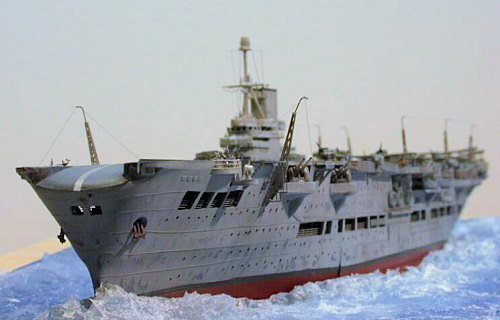 Specifications of
Ark Royal III:
Specifications of
Ark Royal III:
Displacement: 22,000 tons Length: 800 ft (244 m) overall / 721.5 ft (220 m) waterline
Beam: 94.8 ft (28.9 m) Draught: 28 ft (8.5 m)
Machinery: 6 Admiralty 3-drum boilers / 3 Parsons geared turbines
Speed: 31 knots (57 km/h) Range: 7,600 nautical miles (14,075 km) at 20 knots (37 km/h) Complement: 1,600 officers and men
Armament: 16 x 4.5
in (114mm) (8 × 2) 48 x 2 pounder (1.5 in) Pom-Poms (6 × 8)
32 x .50 calibre (12.7 mm) machine guns (8 × 4)
Armour: 4.5 in (114 mm) belt 3.5 in (89 mm) deck over boiler rooms and magazines
Aircraft: 60 to 72 Motto: Zeal Does Not Rest
Laid down: 16 September, 1935
Launched: 13 April, 1937
Commissioned: 16 December, 1938
Fate: Sunk 14 November, 1941, after being torpedoed on the previous day
A brief summary of her service:
HMS Ark Royal was first stationed with the Home Fleet at Scapa Flow. Upon the outbreak of hostilities she and the carriers Courageous and Glorious operated against submarines as hunter-killer groups. Despite Courageous being lost to submarine attack in this high-risk task, Ark managed to evade two torpedoes fired by U-39. Her screening destroyers damaged the submarine and forced it to surface. One of the Ark´s Blackburn Skua Fighter / dive bombers also claimed the first enemy aircraft shot down by british carrier, a Dornier flying boat on 26 September, 1939.
She again narrowly escaped destruction that very day when a 1,000 kg bomb dropped by a Heinkel 111 bomber missed her only a 100 ft. The following day Germany for the first time declared her sunk upon the bomber pilot´s misleading report, the german propaganda publicly asking: "Where is the Ark Royal?"
Soon after, Ark was ordered to the South Atlantic to assist in the hunt for the german pocket battleship Graf Spee. Although she could not have engaged the german raider, it was in part her reputation that caused Kapitaen Langsdorff’s decision to destroy his ship instead of fighting against seemingly overwhelming odds. The British had staged a successful ruse that was intended to convince Langsdorff that the Ark was within striking distance whereas she actually was well out of range at Rio, some 1000 miles away.
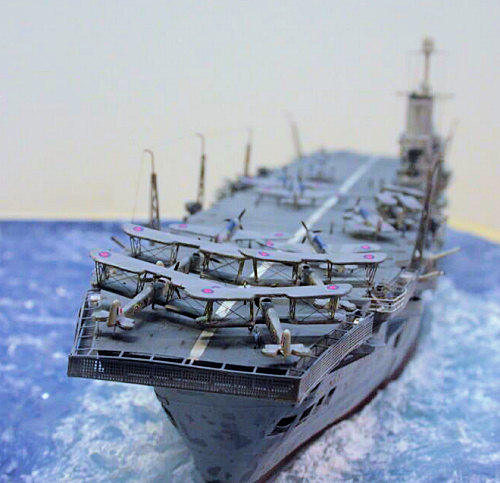 Ark
participated in the ill-fated and ill-led Norwegian campaign in the spring of
1940. While the ship was still in the Mediterranean, on 10 April 1940 her
disembarked Skua fighter/dive bombers managed to sink the german cruiser
Koenigsberg in Bergen harbour - a boost in morale for the Fleet Air Arm and
their second-rate planes. Hastily deployed to Norway to aid the british ground
forces, Ark arrived off the Norwegian coast in late April to receive
the Luftwaffe´s special attention yet again. During aerial attacks there were
several spectacular near misses until the carrier was withdrawn on 3 May 1940.
Ark
participated in the ill-fated and ill-led Norwegian campaign in the spring of
1940. While the ship was still in the Mediterranean, on 10 April 1940 her
disembarked Skua fighter/dive bombers managed to sink the german cruiser
Koenigsberg in Bergen harbour - a boost in morale for the Fleet Air Arm and
their second-rate planes. Hastily deployed to Norway to aid the british ground
forces, Ark arrived off the Norwegian coast in late April to receive
the Luftwaffe´s special attention yet again. During aerial attacks there were
several spectacular near misses until the carrier was withdrawn on 3 May 1940.
The german attack on France on 10 May 1940, worsened the situation and allowed the new british government led by Winston Churchill to give up the Norway campaign. Together with the carriers Furious and Glorious, Ark Royal was deployed covering the retreat. On the 8 June , while returning to Britain, HMS Glorious was lost to the guns of the battlecruisers Scharnhorst and Gneisenau. Fortunately for the british troop convoy, Glorious´ two escorting destroyers suicidally attacked the far superior battlecruisers, scoring a torpedo hit on Scharnhorst before being destroyed. As a result the german ships did not pursue the convoy but retreated to Trondheim for repairs. An ill - conceived british attempt at sinking them using 15 of Ark´s Skuas led to the loss of eight planes for only one bomb hit, which merely bounced off the battlecruiser´s armor.
After the fall of France Ark accompanied HMS Hood in her deployment from Scapa to Gibraltar, arrving there in late June to form the british Force H in the Mediterraean. Ark participated in the attack on her former french allies at Mers-el-Kébir. Her captain Cedric Holland, former naval attaché to the british embassy in Paris, was tasked with negotiating with the french Admiral Gensoul. During the ensuing fight, she lost several planes yet scored no hits. The following September Ark Royal took part in a second attack on the French Navy, this time at Dakar. Her Swordfish attacked the French battlecruiser Strasbourg, no hits were scored and the French ships escaped.
For the remainder of her career Ark went through the many fierce fights with the italian Navy and german Luftwaffe in the struggle for control of the Mediterraean. She escaped various german and italian attacks and was again declared sunk on several occasions. Ark covered many of the highly dangerous Malta convoys. She staged various attacks on italian bases, both on the mainland and on Sardinia. Between these arduous duties, Ark hunted the german battlecruisers Scharnhorst and Gneisenau during their raid into the Atlantic in March, 1941 and took a decisive part in the hunt for the Bismarck. It was one of her obsolescent Swordfish torpedo planes that scored the hit that jammed Bismarck´s rudder and made her easy prey for the british surface fleet.
Ark spent her last months again back in the Mediterraean , escorting convoys to and supplying fighter aircraft to Malta. . Returning from one such mission headed for Gibraltar, she was hit by a torpedo fired from U-81 (Kapitaenleutnant Guggenberger) at 15:41 on 13 November 1941.
The Torpedo hit on the starboard side below the bridge, knocking out the electricity switch room and the telephone exchange. The starboard power train was also disabled. Flooding soon caused a list to 18 degrees. The ensuing confusion and possibly deficient expertise led to fatal decisions. Fearing similar large loss of life as in other british carriers torpedoed before, the captain ordered the ship to be evacuated soon after the hit. The escorting destroyer HMS Legion came alongside to take over personnel. Only then were more favorable reports received and damage control measures taken - but only after 49 minutes had elapsed and after most of the key personnel needed in damage control had left the ship. Fortunately just one crew member was killed.
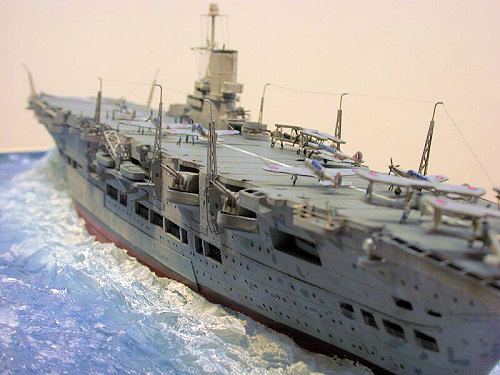 Because there was a
lack of specialist expertise in the remaining damage control parties, only half
of the available compartments on the port side were counter-flooded (which
reduced the list to 14 degrees), To make matters worse, the flooding valves
were then not closed, so that the water in the counterflooded units was
gradually expelled as more water entered the starboard side of the ship.
Because there was a
lack of specialist expertise in the remaining damage control parties, only half
of the available compartments on the port side were counter-flooded (which
reduced the list to 14 degrees), To make matters worse, the flooding valves
were then not closed, so that the water in the counterflooded units was
gradually expelled as more water entered the starboard side of the ship.
Flooding and the loss of feedwater had already shut the ship's power-plant down. As all of the generators were steam-powered, the ship was deprived of electrical as well as motive power. The engineers fought to get the plant back on line despite rising floodwaters. They won that battle five hours and 34 minutes after the torpedo hit when the portside boiler room was lit off.
However by now the list had increased to 18 degrees and the flooding was spreading across the ship's boiler room flat. This was an uninterrupted compartment running across the whole width of the ship, rendering the entire machinery space vulnerable. The efforts made by the engine room crews to restore power were futile. The boiler room flat flooding forced the plant to be shut down again.
Progressive flooding now increased the list rapidly, reaching 20 degrees 11 hours and 4 minutes after the hit and increased to 27 degrees an hour and a quarter later. At this point the abandon ship order was again given. All crew were off the ship at 0430hrs, 12 hours 19 minutes after torpedo striking, at which time the list had reached 35 degrees. HMS Ark Royal capsized and sank at 0619hrs after the listed to 45 degrees.
At the end of WW2 the sinking of Ark Royal was investigated. The conclusion drawn was that, on a target of 22,000 tons, the provision of an effective anti-torpedo scheme was difficult. However, when the loss of the Ark was compared with the loss of USS Yorktown , damaged at Midway, it was demonstrated that it was possible and Yorktown had only sunk when all her reserve buoyancy had been exhausted. The primary cause of the loss of Ark Royal was therefore held to be the inexperience and poor judgement of those responsible for damage control. Proper measures were not undertaken in good time, nor was action to tow the ship to Gibraltar, less than 25 miles away, undertaken promptly.
The Investigation also concluded that there were a variety of design factors contributing to the loss:
· The uninterrupted boiler room flat was a significant error: it was immediately rectified in the Illustrious and Indefatiguable classes.
· The adoption of a double hangar had forced the use of cross-deck uptakes low in the ship, adding to vulnerability.
· The reliance on steam generators was also an error: diesel generators were retrofitted to the armoured carriers.
· The power train design itself was strongly criticised.
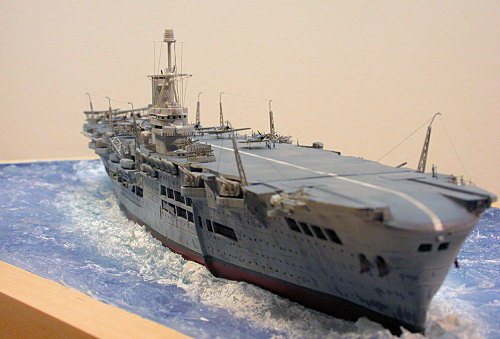 Ark´s
captain, Loben Maund, was court-martialled after the loss of his ship. He was
accused of negligence of his duties, of failing to take proper steps to ensure
the safety of the ship after the torpedo hit and of failing to ensure the ship
was in a proper state of readiness to deal with possible damage. In the trial
held in February of 1942, Capt Maund was found guilty of failing to make sure
proper damage control parties stayed aboard ship after the rest of the crew had
been evacuated. Moreover, it was found that the ship was not in a sufficient
state of readiness to deal with possible damage.
Ark´s
captain, Loben Maund, was court-martialled after the loss of his ship. He was
accused of negligence of his duties, of failing to take proper steps to ensure
the safety of the ship after the torpedo hit and of failing to ensure the ship
was in a proper state of readiness to deal with possible damage. In the trial
held in February of 1942, Capt Maund was found guilty of failing to make sure
proper damage control parties stayed aboard ship after the rest of the crew had
been evacuated. Moreover, it was found that the ship was not in a sufficient
state of readiness to deal with possible damage.
Nonetheless, the members of the court martial backtracked from their judgement soon, stating in a memorandum to the Admiralty that Maund might rather have committed an error in judgement than negligence and that he had perhaps paid too much attention to the safety of his crew than to the saving of his ship. Maund´s career did not suffer from the verdict; only six months later, he became head of the Directorate of Combined Operations in the Middle East. He participated in planning the invasions in North Africa and Italy, and was given the acting rank of Rear Admiral.
The Ark remains to this day a famous and affectionately remembered vessel, a lucky ship throughout her short and eventful career, the first truly modern British carrier. It´s well worth speculating what she might have achieved with equally modern aircraft. The efforts made by the BBC 2002 expedition to find her and the media attention that raised shows that the myth of the "Mighty Ark" still lives
| THE KIT |
This model kit - as have many Airfix offerings - has probably been around all of my life (I´m 44). As is typical for the better Airfix products of its time and it looks reasonably close to the subject to my eyes. It is still cleanly molded (I bought mine in 2005 from the discount box of a vendor at a model show and it is one of the newer issues). There are the usual oversized finer parts such as antenna booms and cranes, pompoms and guns and boats that are nothing to write home about. Although there´s next to no flash, there are a number of annoying sink marks, mostly on the gun turrets.
Prior to actually starting the build I consulted what references I had and thought about what I intended to improve. I had bought the Morskaya Kollektsiya booklet and found it of limited use; the BBC´s Mike Rossiter book of his search for the Ark gave a nice historical overview and a number of photographs far better reproduced than those in the russian publication. Various online resources were consulted and modeling friends picked for trivia - thank you, guys!
I had aquired the (to me) indispensable WEM PE set. As usual with WEM it pays to read the instructions and suggestions very carefully, as there are some pretty helpful parts mentioned on the last page as, well, suggestions.
| CONSTRUCTION |
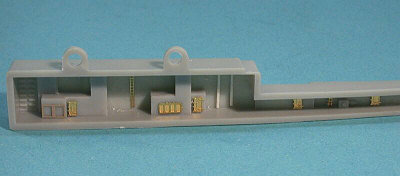 Unlike other
surface ships, a carrier has far less superstructures atop her main deck, but
some quite interesting - and sometimes visible – interior areas . Ark has
several hull inserts harbouring her boats that make her hull visually involving.
The model has nice fore and quarter decks, both of them visible. Therefore
building the hull is more of an effort than with an average destroyer or
battleship. Upon examination of my references I found several points to
improve .
Unlike other
surface ships, a carrier has far less superstructures atop her main deck, but
some quite interesting - and sometimes visible – interior areas . Ark has
several hull inserts harbouring her boats that make her hull visually involving.
The model has nice fore and quarter decks, both of them visible. Therefore
building the hull is more of an effort than with an average destroyer or
battleship. Upon examination of my references I found several points to
improve .
Construction begins
I glued the hull
halves together and then tried to determine how I wished to present the model.
I normally try to dispatch with the messy and perilous (for fine details) job of
placing the model in a water base as early as possible. In this instance I
wanted to depict Ark in her last months in the Mediterraean, and I wanted
to show her under way in a rough sea. Hence I did not remove the
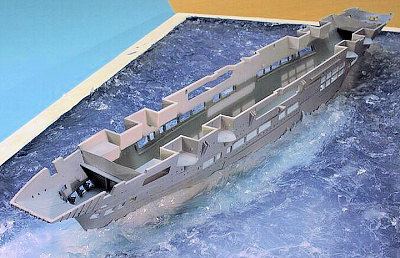 lower hull (her
draft is less than an inch anyway, so she would not take up much vertical space
in a base) and was able to show her with a list to starboard thereby exposing
her lower hull in places.
lower hull (her
draft is less than an inch anyway, so she would not take up much vertical space
in a base) and was able to show her with a list to starboard thereby exposing
her lower hull in places.
The base
I bought a reasonably sized picture frame that would still fit on the shelves of my IKEA cupboard, removed the glass and cut a piece of styrofoam to fit within . This was carved out for the ship´s underwater hull and then painted in shades of blue. My impression of the Mediterraean is a deep shade of blue; I chose a rich blue, lightened around the hull where there would be foam and wake. The ship was then insulated using broad Tamiya tape and liquid soap and placed in situ. Then I broke out the big silicone gun.... in creating the base I emptied three large cartridges of clear silicone caulking into the frame, the contents of which were sculpted using various tools (amongst them my fingers insulated with liquid soap). The sheer amount of silicone adds a considerable depth to the water. The areas around the ship and the wavetops were drybrushed using white enamels.
I have since learned that using artist´s oil paints works much better. The inevitable shrinking of the material necessitated some corrections, of course such a chunk of silicone took ages to dry clear, but in the end I was rather satisfied with the outcome, Eeven more so now that I could remove and replace the ship at will.
The hull
 In checking my
references, I listed what to correct about the hull.
In checking my
references, I listed what to correct about the hull.
- The numerous scuttles were drilled out using a 0.5 mm hand-held drill. I should have made sure I had better alignment and will try for a better result in my next projects. Jim Baumann recommended using Tamiya tape as a guide.
- The armor belt was cut to size from sheet styrene and glued with CA, for fear of the styrene glue melting the thin sheet.
- The degaussing coil was added from the excellent WEM set.
- Ark had
some very prominent raised lines along her hull, probably weld lines. These were
tediously recreated using stretched sprue glued with ethyl acetate (use that in
a well - ventilated environment only!) The very prominent stern overhang was
detailed likewise as per references - it wasn´t as smooth as presented in the
model.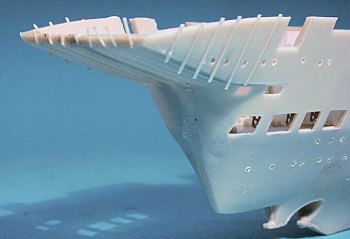
- Her bow had two openings for fairleads, missing in the model. These were cut out and shaped. Fairleads were added from scrap material.
- Above these openings, a projecting bracket for the navigation light was added. The opening for the ship´s siren was made using a heated needle.
- I did not pay
enough attention to the WEM instructions, and so did not at that stage grind off
the attachments for the antenna booms. I had to do that later when a
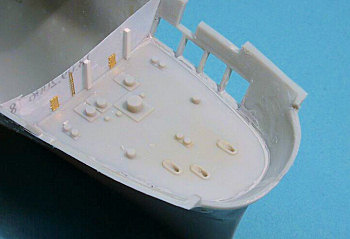 lot of flimsy detail had already
been added and would have far preferred having been more attentive to the WEM
instructions at this early stage.
lot of flimsy detail had already
been added and would have far preferred having been more attentive to the WEM
instructions at this early stage.
- The various hull inserts were cleaned up and detailed with PE watertight doors and what scrap PE items I fancied - a bit like detail work on a Star Wars spacecraft.
- The fore and quarter decks were detailed as follows: The moulded-on anchor chains were ground off, hawsepipes opened, PE chain was added. Both decks received bulkheads made from CA-infused paper, detailed with watertight doors, ladders and various pipes. The framework with lightening holes visible through the stern openings was recreated using surplus boat cradles from WEM´s indispensable 1:700 Askold set.
| COLORS & MARKINGS |
At this stage, the hull and its inserts were painted. Ark´s paint scheme is still subject to discussions. I did my own asking and looking around and guessing and arrived at the conclusions detailed below. My thanks go to Rob Kernaghan for his helpfulness.
Prior to her sinking, Ark wore AP507 C throughout, the lighter Mediterraean grey. It had been hastily applied above her earlier AP 507 B medium grey scheme and weathered quickly under the arduous service imposed on ship and crew, thus exposing the darker 507B. This is most visible on the images taken prior to her loss from close up. I do not follow the reading that she wore a two tone scheme, with the upper area of her hull in 507C and the lower in a darker grey. My personal interpretation is that this effect is due to the notable kink in her frames that leaves the lower areas in shadow, rendering them a darker shade.
I tried to reproduce the war-weary and weatherbeaten look of the ship in the following manner:
I first sprayed the entire hull in Humbrol 145, closely resembling AP 507B - as a a primer and to check for flaws. After corrections, the waterline area was sprayed dark grey.
After drying this area was masked using a narrow vinyl masking strip. Then the lower hull was sprayed WEM RN antifouling red.
After drying, this in turn was masked and the upper hull was sprayed Humbrol 145 again. This was left to dry thoroughly, then I applied a good coat of Future floor polish to act as a non-lacquer-based barrier. And now I was able (after some days drying time) to apply the final WEM AP 507C coat of paint. Upon drying, I could now chip this top coat off down to the Future, thus exposing the darker underlying grey.
The hull inserts were painted Humbrol 145 for the vertical and Model Master Gunship Grey for the horizontal areas.
| CONSTRUCTION CONTINUES |
Detail work
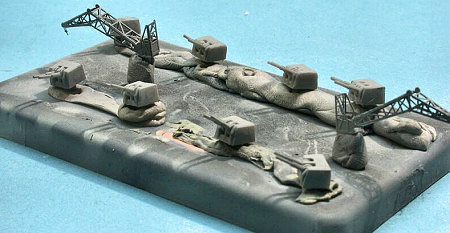 Next to this work,
I prepared the numerous sub-assemblies. Those needed first were the various
boats. I limited myself to cleaning them up and filling the most offending sink
marks, plus painting windows with a fineliner pen. They were added to the hull
inserts before they were glued to the hull. At this stage, I also added the
railings before gluing the inserts - much easier! The boat cranes were made from
WEM parts, yet added only later. The 4.5 in turrets needed serious filling of
their sink marks. Pom-Pom´s and quadruple 0.5 in MG´s were (more or less
patiently !) built from WEM PE parts, an excercise that pays off.
Next to this work,
I prepared the numerous sub-assemblies. Those needed first were the various
boats. I limited myself to cleaning them up and filling the most offending sink
marks, plus painting windows with a fineliner pen. They were added to the hull
inserts before they were glued to the hull. At this stage, I also added the
railings before gluing the inserts - much easier! The boat cranes were made from
WEM parts, yet added only later. The 4.5 in turrets needed serious filling of
their sink marks. Pom-Pom´s and quadruple 0.5 in MG´s were (more or less
patiently !) built from WEM PE parts, an excercise that pays off.
Adding the deck
I had of course test-fit the deck earlier on and had been pleased by a generally nice fit. Prior to adding the deck, I ground off most of the moulded-on detail due to be replaced by PE parts, but I retained the moulded on arrestor wires. I had decided to present the lifts in the up- position, so not much extra work was needed. After gluing the deck to the hull, some limited filling and sanding was needed, but nothing painful. At this stage, PE deck details, such as windbreaks, crash barrier, catapult rails and so on were added.
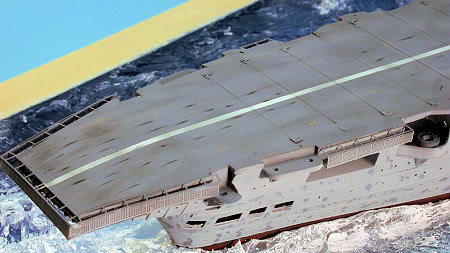 I had wondered
and asked a lot of questions about the colour and markings of Ark´s flight deck,
and had examined what images were available to me. In the end I decided to paint
it Gunship Grey with a single white centerline stripe. Hence, that stripe was
sprayed first using Xtracrylix white (which dries very fast), then masked off
using the same vinyl tape used for the boot topping. Now I could add the
Gunship Grey, which was varied in hue to make things a bit more lively. After
drying, I removed the masking tape and weathered the deck using a glass fibre
pencil and pastel chalks. Tyre scuffing was replicated using black pastel chalk.
I had wondered
and asked a lot of questions about the colour and markings of Ark´s flight deck,
and had examined what images were available to me. In the end I decided to paint
it Gunship Grey with a single white centerline stripe. Hence, that stripe was
sprayed first using Xtracrylix white (which dries very fast), then masked off
using the same vinyl tape used for the boot topping. Now I could add the
Gunship Grey, which was varied in hue to make things a bit more lively. After
drying, I removed the masking tape and weathered the deck using a glass fibre
pencil and pastel chalks. Tyre scuffing was replicated using black pastel chalk.
More fiddly stuff
I proceeded adding the various catwalks running around the deck, most notably around the stern overhang. Those were fiddly parts and hard to apply to the complex shape of the stern, but using a lot of patience I succeeded. It was at that stage that I realized I should have ground off the mounts for the antenna booms much earlier. It was tougher now than it had been before, but I succeeded and added the PE/styrene mounts. Now I could touch up the paint in those areas.
The island
I had contructed
the island quite early on, but now was the time to add it to the flight deck.
Modifications to the island were *mostly* as per WEM instuctions, apart from two
errors.... I overlooked that WEM had already provided bridge windows and roof,
so I made mine from spare PE rails and CA-infused paper. Additionally I also
overlooked how comprehensive the supplied mast details were, so I made some
stuff myself which was present in the set. Nonetheless I managed to lose one of
the yardarms so had to resort to the legendary Askold set for spares. Generally,
I thinned out the styrene parts as I could, rendering the splinter shields
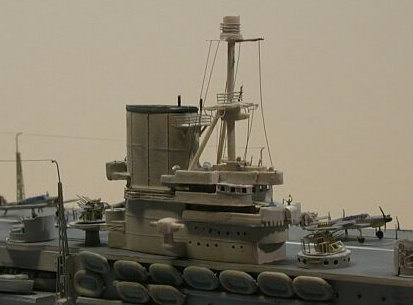 more
to scale. I added the PE funnel cap and scribed the smooth funnel to make it
look a bit more real. Watertight doors were added where appropriate. The island
was painted AP 507 C and finally glued to the flight deck. The fiddly Pom - Pom
mounts were rolled and glued as per instructions, sprayed AP 507 C and added
ahead and astern of the island. At this stage, I also added the remaining
subassemblies such as 4.5 in guns, Pom-Pom´s and MG´s, cranes and antenna booms.
The latter were glued in the raised position as I didn´t want to portray the
ship during flight ops.
more
to scale. I added the PE funnel cap and scribed the smooth funnel to make it
look a bit more real. Watertight doors were added where appropriate. The island
was painted AP 507 C and finally glued to the flight deck. The fiddly Pom - Pom
mounts were rolled and glued as per instructions, sprayed AP 507 C and added
ahead and astern of the island. At this stage, I also added the remaining
subassemblies such as 4.5 in guns, Pom-Pom´s and MG´s, cranes and antenna booms.
The latter were glued in the raised position as I didn´t want to portray the
ship during flight ops.
Weathering
I weathered the ship using a combination of watercolors, pastel chalks and glass fibre pencil scuffing. There is some rust streaking, some grime and a lot of paint chipping. At this stage I also added the anchors. I had lost the kit anchors so resorted to the PE items from WEM. To give them more "body", I dipped them in black acrylic paint, let them dry, and then drybrushed Model Master exhaust metalizer and rust red pastel chalk. I´m more satisfied with the result than expected.
The airgroup
Ark´s maximum complement were 72 planes. Airfix supplies just 12, six Fairey Fulmar fighters and Swordfish bombers respectively. Two planes of each type have folded wings. Given the vintage of the kit, they are pretty crude yet reasonably true to shape. The WEM set contains very delicate PE parts to bring them more up to modern standards.
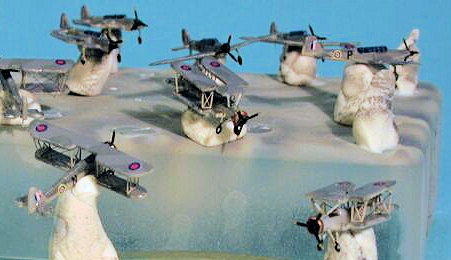 Before I dared try
my luck at this extremely fine stuff, I had to make sure about the colour scheme
and markings. WEM recommends Sky Grey undersides and a camo scheme in Slate Grey
over Extra Dark Sea Grey. No decals are supplied and I did some asking and
looking around, until Jim Baumann again came to the rescue sending me a review
of Starfighter Decals 1:600 Fleet Air Arm 1940-44 decals - just what I needed.
Mark from Starfighter Decals did a marvellous job and supplied me with a decal
sheet within three days, so I was running out of excuses why not to start
tackling the planes.
Before I dared try
my luck at this extremely fine stuff, I had to make sure about the colour scheme
and markings. WEM recommends Sky Grey undersides and a camo scheme in Slate Grey
over Extra Dark Sea Grey. No decals are supplied and I did some asking and
looking around, until Jim Baumann again came to the rescue sending me a review
of Starfighter Decals 1:600 Fleet Air Arm 1940-44 decals - just what I needed.
Mark from Starfighter Decals did a marvellous job and supplied me with a decal
sheet within three days, so I was running out of excuses why not to start
tackling the planes.
I started with thinning the wings down a bit and removing the moulded on "undercarriage" stubs. The cockpits of the Fulmar’s were detailed with careful cuts from my razor saw, rendering some structure in that area. I might also have cut open the ailerons but decided against that. Then the planes were mounted on heated pins which in turn were planed in a styrofoam board. I sprayed them WEM RN G45 for the undersides and (I knew I had to admit that one day) Luftwaffe RLM 74 and 75 for the camo. I hoped to get away with that choice of color due to the scale effect. Pure EDSG looked much too dark for me, so I tried to find hues that corresponded to the image I had in my mind. The Fulmars´ cockpits were painted blue. Prior to decaling, the planes were covered in Future gloss to counter silvering.
I did some looking and asking ref the correct markings yet only after I had decalled did a helpful sould turn up at MW.com. So I stuck with the more generic info and used the correct fin flashes, type B roundels to the upper surfaces, type A roundels with yellow surround for the fuselage, and mostly just one code letter for the individual aircraft. The decals worked fine with Micro Sol, but as they are supplied on a sheet of continous carrier film they need careful trimming before application.
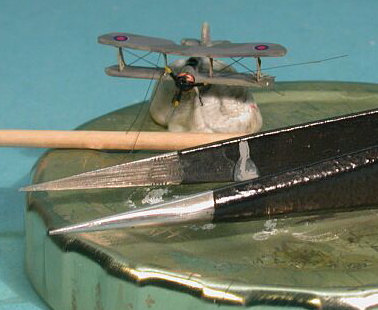 Then I started on
a Fulmar using the PE. I could not, for love nor money apply the supplied
tailwheels - they simply vanished in thin air upon removal from the fret, being
only slightly larger than a lone bacterium. I replaced these missing PE items
with stretched sprue. The remainder of the Fulmar PE went down well. I had
sprayed all the aircraft PE black on the fret and touched up with the
appropriate paints after application. Thus, the undercarriage and wheel well
doors were painted in the underside colors, whereas the props were touched up in
black, with yellow tips added.
Then I started on
a Fulmar using the PE. I could not, for love nor money apply the supplied
tailwheels - they simply vanished in thin air upon removal from the fret, being
only slightly larger than a lone bacterium. I replaced these missing PE items
with stretched sprue. The remainder of the Fulmar PE went down well. I had
sprayed all the aircraft PE black on the fret and touched up with the
appropriate paints after application. Thus, the undercarriage and wheel well
doors were painted in the underside colors, whereas the props were touched up in
black, with yellow tips added.
The Swordfish were more complex, yet surprisingly workable. The upper wings needed some bending prior to mating to the PE struts, but all held well. I even got brave enough to add rigging from stretched black sprue. In all, applying PE took about 20 minutes per plane, the rigging about half that amount. I glued the sprue with styrene glue only, dipping the beginning of the filament in glue, placing it where desired, and then gluing the end and removing the excess with a sharpened toothpick dipped in glue.
The crew
I always try something new in each project. This time it was working with tiny aircraft and adding PE figures. I had aquired a fret of Lion Roar´s 1:700 PE crew figures at a recent meeting for a very competitive price and was eager to use them. I sprayed the whole figures on the fret using flat blue, then picked out details with a very fine brush and acrylics - black shoes, tan faces and arms and so on.
It all comes together
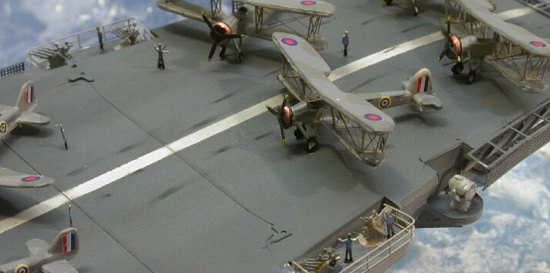 Having completed
sub-assemblies so far, I started one early morning by snipping off the figures
from the fret and collecting them in an old Tupperware container. Then I started
gluing them to the ship, beginning with the gun sponsons and hull openings,
working my way ever more up. CA worked well with me for that task. Thereafter I
placed the planes on the deck, gluing them with CA also. Now I could add more
figures to the deck and stopped when I thought there were enough of them (though
there are just about 50 or 60 figures there), and continued with rigging, again
using black stretched sprue. This went fairly well save the antennas which were
a genuine pain due to their flimsiness and constant danger of snapping upon
touching them inadvertently. With some corrections I could breathe a sigh of
relief and consider the model complete.
Having completed
sub-assemblies so far, I started one early morning by snipping off the figures
from the fret and collecting them in an old Tupperware container. Then I started
gluing them to the ship, beginning with the gun sponsons and hull openings,
working my way ever more up. CA worked well with me for that task. Thereafter I
placed the planes on the deck, gluing them with CA also. Now I could add more
figures to the deck and stopped when I thought there were enough of them (though
there are just about 50 or 60 figures there), and continued with rigging, again
using black stretched sprue. This went fairly well save the antennas which were
a genuine pain due to their flimsiness and constant danger of snapping upon
touching them inadvertently. With some corrections I could breathe a sigh of
relief and consider the model complete.
| CONCLUSIONS |
A very nice kit, despite its age and shortcomings soundly designed and with some extra work looking the part. It also was a good opportunity to learn more about the RN´s and FAA´s history and dive into the dark times of early WW 2. Highly recommended!
| REFERENCES |
Printed Sources:
- Morskaya Kollektsiya Nr. 4 / 2001
- Mike Rossiter: Ark Royal. London 2006
- 80 Years of the british aircraft carrier. Fleet Air Arm Museum Yeovilton, 1994
- Roger Hayward: The Fleet Air Arm in camera, Stroud 1998
Online Sources:
- Wikipedia (!!!) http://en.wikipedia.org
- Maritimequest http://www.maritimequest.com/warship_directory/great_britain/pages/aircraft_carriers/hms_ark_royal_91.htm
- http://www.kbismarck.com/arkroyal.html
- Conversations on modelwarships.com´s forum http://www.shipmodels.info/mwphpBB2/viewtopic.php?t=4870
Credits:
Many thanks to all the modeling buddies out there who helped me in building this kit, with special honorable mention of the fine folks on mw.com´s forum, Rob Kernaghan who shared his findings on Ark´s color scheme and to Jim Baumann for revising my text into proper British grammar – all remaining errors and typos are mine!
January 2007
If you would like your product reviewed fairly and fairly quickly, please contact the editor or see other details in the Note to Contributors.